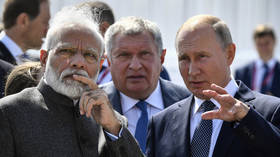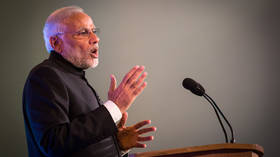Multi-polar world: Why the current crisis is bringing India and Russia even closer

The Ukraine crisis has exposed a dramatic shift in the structure of international relations. This manifests itself in the acceleration of Russia’s shift towards Asia and in the divergence of interests between major powers.
The breakdown is a symptom of a more fundamental process: A rift in mutual understanding. Something that is not a phenomenon restricted to the current year.
Although we can hardly determine the commencement date – due to its blurred and volatile nature – the symptoms are visible. Sanctions policies, trade wars, controversies around Covid-19, protectionism, Iran and North Korea's nuclear issues, and the US withdrawal from Afghanistan are just a few examples of a world in a state of turmoil.
The current crisis has only accelerated the widening gap and the growing misunderstanding. The new landscape necessitates a certain self-reflection and a reassessment of the values and principles of cooperation on different levels. At least this is how it seems from Moscow.
However, the fact that similar signals are visible in other parts of the world is suggestive that the issues of reconfiguration are very relevant. This situation was well reflected by Indian External Affairs Minister Subrahmanyam Jaishankar on the sidelines of the Raisina Dialogue.
While countering criticism over New Delhi’s stance, he emphasized that the current crisis could be a “wake-up call” for Europe to also look at things that have been happening in Asia for ten years. This is a reflection to the state of somnambulism which is characterized by neglecting the crises in Asia and misunderstanding the national interests of the Global South.
For example, it is now shown that the position of Western countries towards India amounts to “you are either with us, or against us.” Such a stance looks especially unfounded, given that for the first two months of the Ukrainian crisis the EU countries accounted for more than 70% of Russian fossil fuels exports, and the share of the US imports surpasses India’s. Moreover, it seems that Western attitudes show a lack of understanding of India’s role in the international arena and the history of the country’s development.
After gaining its independence, the political culture of India was based on three pillars: The quest for a bigger political and economic status, the principle of neutrality, and the attempts to take and extend its moral stance as a voice of the post-colonial world whenever possible. The balanced policy stance was clearly marked by Jawaharlal Nehru even before the country's independence and eventually macro-objectives of this foreign policy became a matter of national consensus.
On the international stage, this attitude was institutionalized in the Non-Aligned movement and, after the collapse of the bi-polar system, was modified in “multi-alignment.” Indeed, India’s policy from time to time showed some convergence with the USA and the USSR but it endeavored to counterbalance the positions of the countries. Notwithstanding conceptual modifications, the essence of the foreign policy remained intact: India is pursuing its well-balanced position and explicitly expresses the interests of developing countries. In general, this policy safeguarded functional, co-existential, and existential national interests of the country at that time.
The core of the functional aspect is durable economic growth that was firstly oriented on the domestic market. At the end of the century, reforms on liberalization added an external dimension to this element. Despite some socio-economic obstacles, the results for now are obvious: India has become one of the major economic powers.
The developmental pattern can be expressed as an interplay between the principles and interests of India’s national policy. For many in India, America’s policy was considered harmful towards the three above-mentioned dimensions. The chaotic withdrawal from Afghanistan and a difficult-to-predict sanctions policy towards Iran from two successive administrations are clear examples. Despite the fact that India and the US tried to calibrate their positions on Chabahar port and oil imports, the restrictions imposed added a factor of uncertainty, which halted economic and connectivity cooperation and hurt energy security, which is a matter of high relevance to India’s economy.
Due to the fact that the current crisis does not send signals of attempts to reach mutual understanding, the only way to reassess the values is to find new goal-oriented ways and sources of cooperation. This would also be true for Russia, which is seeking Asian directions for economic interaction. It may also refer to India, which will receive political and economic benefits by being a mediator between the countries and gaining financial benefits from more lucrative deals and an increased role as an economic hub.
One of the key areas of time-tested cooperation between Russia and India is a military sphere which has endured the test of time. For example, India’s military imports were a lifeline for the Russian sector after the collapse of the Soviet Union. But due to the fact that the overall commodities turnover is about $12 billion and contributes only 1.3% of the total trade, there is still room for improvement.
Agriculture
Despite low dependence on agriculture imports, which is declining due to growing domestic production, Russia traditionally plays an important role in India’s access to edible oil and fertilizers. At the same time, the Russian Federation understands that with the course of the crisis, India is taking a more export-oriented position. This does not necessarily mean a conflict of interests.
First of all, despite rather large grain reserves, the country is not immune to climate anomalies, especially heat waves, cyclones and floods. Secondly, domestic consumption will ensure the need for grains, oil, fodder (given the extensive growth of livestock) and other products in a mid-term perspective. Low-price transactions make this field of cooperation even more attractive. Thirdly, mutually beneficial partnership can be extended to other countries where there is a huge need to ensure food security. For example, in the case of Bangladesh, it will help to “mitigate” occasional tensions with India over migration.
Energy cooperation
India is now pursuing energy transition initiatives that aim to increase the proportion of renewables. The key aspect here is the government’s commitment to ensure the country’s energy security, while the role of conventional sources of energy won’t be subject to a sharp decline. In this regard, Russia can become a profitable partner in the case of coal, gas and oil supplies. Such cooperation would avoid external risks, which partly caused last year’s coal crisis and energy shortage in certain states, yielding the possibility of a discount deal that would bring financial profits.
A one dollar increase in the cost of a barrel of oil would take from the national budget more than one billion dollars. That is why India has placed orders on Russian oil that amounted to twice as much as it purchased in 2021 and is now increasing the share in the Sakhalin-1 project. Moreover, taking into account the smooth increase of gas shares which is supported by initiatives like “One Nation, One Gas Grid” – collaboration in the energy sector is highly beneficial for both sides.
What often remains outside is that Russia can provide support for India’s energy transition initiatives. Firstly, the construction of small hydro stations in Uttarakhand, Arunachal-Pradesh, Himachal-Pradesh, Jammu and Kashmir will help to eliminate energy shortages. Secondly, joint works in the sphere of nuclear power proved to be effective not only in India, but also in other countries – look at Rooppur Power Plant as an example. The relevance of energy multilateral regional projects (like Nepal-Bhutan-Bangladesh) will only increase.
Connectivity projects
Many bilateral projects will require a boost in logistical infrastructure. For a long time, cooperation between India and Russia in the field of connectivity progressed very gently. Now, they are being put high on the agenda. First of all, the development of the North-South and Chennai-Vladivostok transport corridors are being updated and the joint implementation of them will ensure higher stability of supplies. Russia is now intensifying negotiations with Iran, the country that can be a “fulcrum” for many trade items. This will not only benefit the infrastructural development of Russian regions and increase bilateral trade. It can also become India’s gate to Central Asia, which is part of the “extended neighborhood.”
However, the level of India’s trade there lags far behind not only the indicators of Russia and China. It is also far behind trade levels with other parts of the neighborhood. Bilateral trade with the Gulf Cooperation Council (GCC) and the Association of Southeast Asian Nations (ASEAN) each account for more than 11 per cent of India’s total trade. Meanwhile, the trade level with Central Asia is more than 50 times lower.
In theory, this project will increase India's position in the region and may become a “counter balance” to China's active economic policy, which is largely a cause for concern for the leaders of the Central Asian countries. What is also important is that the INSTC will be an alternative route to Europe with which India has recently signed a connectivity partnership agreement and which is also highly dependent on Chinese goods.
With the increased focus on the Indo-Pacific, the Chennai-Vladivostok maritime corridor is also becoming very important. India does not see this conceptual framework as a strategy or as a club of limited members. The country is seeking to prevent any single power from dominating the region or its waterways. Thus there is a possibility to boost connectivity projects in order to increase bilateral trade and the roles of India and Russia in the region. Simultaneously, if India can be an alternative in Central Asia, Russia’s increased role can also be positively perceived in South-East Asia.
In fact, the potential for cooperation is not limited to the above areas and can be realized in areas ranging from heavy industry to disaster-resilience infrastructure and smart city initiatives. The Russian position was well expressed by Foreign Minister Sergey Lavrov to India Today. “With India, we supported Prime Minister Narendra Modi’s concept of ‘Make in India’. We started substituting the simple trade with local production, shifting production of the goods needed by India on their territory,” he said.
In conclusion, in difficult times, the ability to find common interests and develop mutually-beneficial practice-oriented projects is particularly pertinent. This is how friendship is tested.
At the same time, the Russian government understands that India will pursue its own national interests and “eternal friendship” does not exist in foreign policy. If earlier relations between countries were not always supposed to have a strong economic foundation, now things are changing. The Soviet-India strategic partnership arose because the countries had sought to find common interests.
Nowadays, economic relations have become more relevant and the countries need to rediscover points of common interest in the economic sphere and develop particular models of cooperation. In order for them to become the hallmark of India-Russia cooperation, there is a huge need for political will from both sides, which derives from the history of our friendship and the principle of mutual respect.















